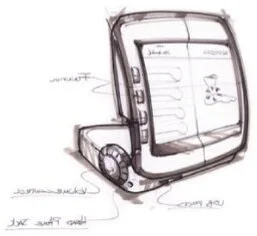u s e r c e n t e r e d d e s i g n g r o u p
As Intel responded to revenue losses from the widespread, capital spending collapse in the internet business and personal computer technology sectors at the turn of the millennium, they recognized their own, internal need to better understand end user consumers as the actual demand drivers to influence the company’s platform development roadmap.
To facilitate this strategic insight, the User Centered Design group (UCD) was formed at Intel’s Hawthorn Farm site in Hillsboro, Oregon, U.S.A. It was a multidisciplinary team of about 40 user experience researchers, designers, and engineers who discovered and translated end user value into tangible, data driven solutions that generated commercial impact for Intel.
UCD investigated and proposed futuristic, end user usage models in various markets, also designing conceptual, digital devices that fit those scenarios. They would then build working prototypes of the devices for Intel’s executive decision makers to interactively experience and assess the concepts for themselves. This delivered a palpable sense of a technology’s market potential—far beyond a product requirements document—allowing the most well informed, business planning choices to be made.
The group comprised 7 product development areas, providing a comprehensive perspective and expertise set to deliver visceral business value.
Design Research | Human Factors Engineering · Investigated human experiences with products, people, and places, to produce findings for usage models, use case definitions, user task flows, interaction models, personas, and user experience requirements that fueled iterative product development. Observations came primarily from personal, interactive interviews with end users and related experts using qualitative and quantitative methods in contextual and controlled settings.
Industrial Design · Controlled the tangible attributes that affect an end user’s sensory experience of and emotional impression of a product. Understanding consumer psychology, market, business, engineering, and manufacturing factors, industrial designers ideated concepts for, and guided the definition a product and its usage through development. They primarily used hand drawn and digitally derived illustrations and animations, actual models, and functional mock ups to convey product concepts.
User Interaction Design · Created conceptual models for, and guided the definition of, how the capabilities of a product were expressed to the end user, and the means for the user to respond to the product in return. Their activities include forming user personas based on design research, building on screen graphical user interfaces (GUI), constructing and communicating usage scenarios via storyboards and paper based GUI simulations, and supporting industrial design.
Media Acoustics Perception Lab · Delivered user perceived video, audio and tactile quality research, requirements, benchmark tools and validation testing to ensure end user satisfaction with a product. Elements they explored included speaker, microphone, video camera and LCD clarity, safe external surface temperatures, acceptable thermal ventilation acoustics, and VoIP quality.
Mechanical Engineering · Found, proved, steered requirements for, and implemented the materials, mechanisms, and manufacturing elements that protect and provide structure for internal product components and interface features, while allowing ease of production. Contributions involved product assembly architecture, external enclosure and internal chassis designs, thermal flows, model and prototype management, material specs, tooling support, production prep, and part inspection.
Hardware Engineering · Found, proved, steered requirements for, and implemented the electrical means to deliver specific, end user product value considering industrial and interface design, end user needs, and production efficiencies. They brought solutions from feasibility studies, to working prototypes to high volume production, with deliverables ranging from board architecture, design and debugging, BOM cost management, competitive analysis, and hardware integration and validation.
Software Development · Synthesized the efforts of user interaction design and hardware engineering to orchestrate firmware, drivers, network protocols and APIs with application requirements to make a platform’s usage real and bring an end user’s experience to life. They also scoped and set application requirements, and handled application development itself.
My plot in an Intel cubicle farm, transforming user contexts into compelling product concepts.
p r o d u c t & e x p e r i e n c e d e s i g n
Joining the User Centered Design group in 2005 was a stimulating career step, given that it constituted a complete, product development group with a global scope but without mass producing end user products per se. As a Senior Industrial Designer, I would apply my creative talents and leadership skills while also imbibing the best practices of enterprise scale, business operations.
The variety of projects included medical, small business, consumer, and commercial market sectors. And, although all our work was inherently high tech oriented to find the next big thing, sometimes the result was to confirm which ideas not to pursue. This, then demonstrating the—perhaps paradoxical—profitability acumen of short term, research and development costs to prevent wasted, long term business investments.
Throughout my employment with Intel I worked with a diversity of extraordinary, yet down to earth, people and learned many new things through the generous opportunities available.
I was exposed to the intersection of corporate, legal, social, political, and technological issues on a planetary scale to expand my personal outlooks too. All of which served as a stepping stone to what was next to come.
And, with Intel’s vast reach and resources, coinciding with the business climate influences at the time, I appreciated participating in what I considered worthy initiatives to support the needs of populations in need—such as the elderly segment requiring in home health care, and the less entitled, emerging market regions of the world. My prior international travels and more recent residency abroad were of direct import within other Intel divisions too.
Desktop computing concept sketch featuring a porthole app touch screen.
Designing a dual, touch screen, notebook computer intended to enable more interpersonal, small business client relationships.
Designing a culturally relative, ultra mobile device for the Middle East | North Africa (MENA) emerging market region.
Designing a 12 inch notebook computer with a revolutionary, platform architecture allowing custom, after market configurability.











